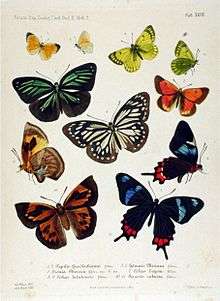Parides gundlachianus
Parides gundlachianus, the Cuban cattleheart, is a species of butterfly in the family Papilionidae. It is an endemic species found only in Cuba. The name honours the Cuban naturalist Juan Gundlach.
| Cuban cattleheart | |
|---|---|
 | |
| Parides gundlachianus in a plate from Reise der Österreichischen Fregatte Novara - at bottom right | |
| Scientific classification | |
| Kingdom: | |
| Phylum: | |
| Class: | |
| Order: | |
| Family: | |
| Tribe: | |
| Genus: | |
| Species: | P. gundlachianus |
| Binomial name | |
| Parides gundlachianus | |
| Synonyms | |
| |
It is the brightest-coloured American swallowtail, and may be recognised by the brilliant blue bands on the forewing. The ground colour is brown to black. The upperside forewing has a blue to green median band and possibly one to two spots close to the apex. The hindwings have a long tail and on either side two indentations like short tails. The upperside hindwing has a broad red submarginal band. A full description is provided by Rothschild, W. and Jordan, K. (1906)[2]
The dark ash-grey larva is striped longitudinally, the head and thoracic legs are black; the black longitudinal stripes in part margined with white; the anterior and posterior segments bear long pointed tubercles which are partly white.
Occurs in the mountainous eastern part of the island, especially near the coast, where it is met with on flowers, and sometimes also drinking at pools.[3]
Subspecies
- Parides gundlachianus gundlachianus (eastern Cuba)
- Parides gundlachianus alayoi Hernández, Alayón & Smith, 1995 (western Cuba)
Taxonomy
Parides gundlachianus is a member of the ascanius species group ("Fringe-spots white. Hindwing with submarginal spots and usnally also diseal spots or dots, or a discal band ;mostly with tail") A quadrate whitish spot in space 2 of the forewings is quite peculiar of the ascanius group[4][5]
The members are
- Parides agavus (Drury, 1782)
- Parides alopius (Godman & Salvin, [1890])
- Parides ascanius (Cramer, [1775])
- Parides bunichus (Hübner, [1821])
- Parides gundlachianus (C. & R. Felder, 1864)
- Parides montezuma (Westwood, 1842)
- Parides phalaecus (Hewitson, 1869)
- Parides photinus (Doubleday, 1844)
- Parides proneus (Hübner, [1831])
Status
Found only in forests in Cuba and not rare but requiring monitoring.[6]
Etymology
The specific epithet honours the Cuban naturalist Juan Gundlach.
See also
References
- C. & R. Felder, [1864]; C. & R. Felder, 1865 Reise der österreichischen Fregatte Novara um die Erde in den Jahren 1857, 1858, 1859 unter den Behilfen des Commodore B. von Wüllerstorf-Urbair. Zoologischer Theil. Band 2. Abtheilung 2.
- Rothschild, W. and Jordan, K. (1906). A revision of the American Papilios. Novitates Zoologicae 13: 411-752. (Facsimile edition ed. P.H. Arnaud, 1967) and online
- Seitz, A. ed. Band 1: Abt. 1, Die Großschmetterlinge des palaearktischen
Faunengebietes, Die palaearktischen Tagfalter, 1909, 379 Seiten, mit 89 kolorierten Tafeln (3470 Figuren)

- Edwin Möhn, 2007 Butterflies of the World, Part 26: Papilionidae XIII. Parides Verlag Goecke & Evers Verlag Goecke & Evers ISBN 9783937783277
- Racheli, Tommaso an Olmisani. Luca 1998. A cladistic analysis of the genus Parides Hubner, [1819], based on androconial structures (Lepidoptera: Papilionidae). Neue Ent. Nachr. (Marktleuthen),41:119-131.pdf
- Collins, N. Mark; Morris, Michael G. (1985). Threatened Swallowtail Butterflies of the World: The IUCN Red Data Book. Gland & Cambridge: IUCN. ISBN 978-2-88032-603-6 – via Biodiversity Heritage Library.
- Hamilton A. Tyler; Keith S. Brown; Kent H. Wilson 1992 Swallowtail Butterflies of the Americas Scientific Pub ISBN 0-945417-91-8
- Lewis, H. L., 1974 Butterflies of the World ISBN 0-245-52097-X Page 26, figure 4 as columbus, figure 10 as gundlachianus.
Further reading
- Lamas, Gerardo (2004). Atlas of Neotropical Lepidoptera; Checklist: Part4A Hesperioidea–Papilionoidea. Gainesville, Florida: Scientific Publishers, Inc. ISBN 0-945417-28-4.